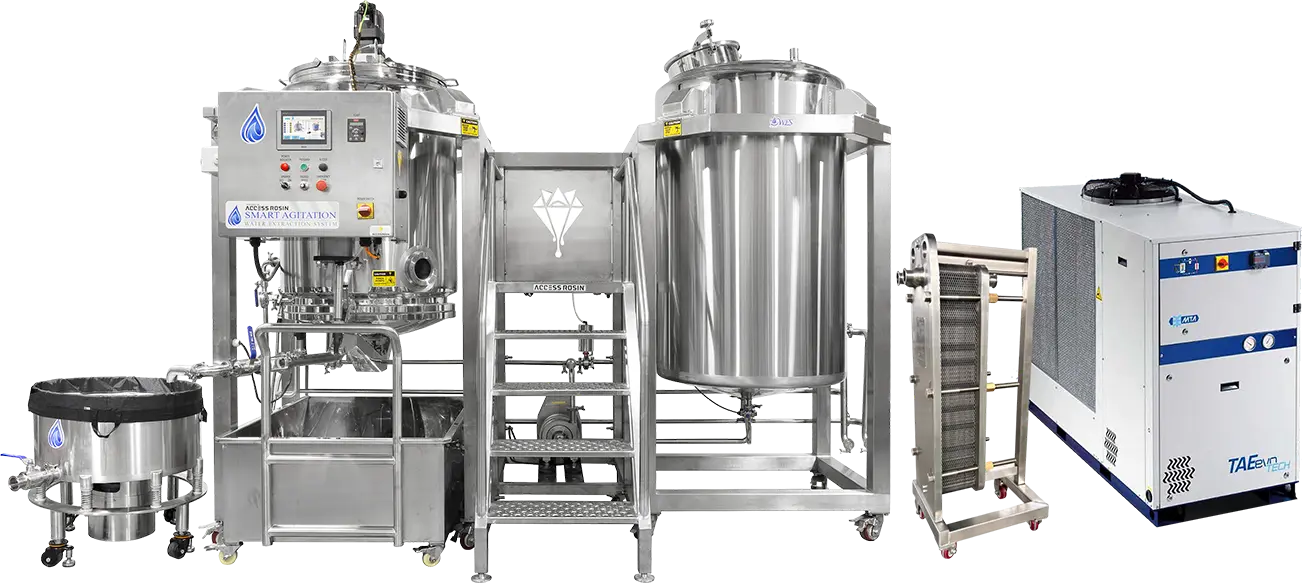As the cannabis industry continues to embrace solventless extraction methods, understanding the intricate details of terpene and flavonoid preservation becomes essential for producing high-quality rosin. Access Rosin’s innovative approach to extraction is rooted in scientific principles that optimize the aroma, flavor, and therapeutic potential of cannabis concentrates. In this blog, we’ll dive into the key terpenes and flavonoids commonly found in cannabis, their effects, and how advanced pressing techniques can help preserve these valuable compounds.
The Importance of Terpenes and Flavonoids in Cannabis
Cannabis is known for its unique terpene and flavonoid profiles, which give each strain its distinct aroma, flavor, and potential therapeutic effects. Terpenes are aromatic compounds responsible for the scent and flavor, while flavonoids provide color and additional therapeutic properties. Together, these compounds contribute to the "entourage effect," where they synergize with cannabinoids like THC and CBD to enhance the overall experience.
Below, we outline some of the most common terpenes and flavonoids in cannabis, including their flavors, effects, and typical sources.
Common Terpenes in Cannabis:
| Terpene | Aroma/Flavor | Potential Effects | Common Sources |
|---|---|---|---|
| Myrcene | Earthy, musky | Sedative, anti-inflammatory, analgesic | Mangoes, hops, lemongrass |
| Limonene | Citrus | Uplifting, anti-anxiety, anti-depressant | Citrus fruits, juniper |
| Pinene | Pine | Alertness, memory retention, anti-inflammatory | Pine needles, rosemary |
| Linalool | Floral (lavender) | Relaxation, anti-anxiety, anti-convulsant | Lavender, mint |
| Caryophyllene | Spicy, peppery | Anti-inflammatory, analgesic, interacts with CB2 receptors | Black pepper, cloves |
| Humulene | Woody, earthy | Appetite suppressant, anti-inflammatory | Hops, coriander |
| Terpinolene | Herbal, floral | Antioxidant, sedative, anti-bacterial | Nutmeg, tea tree |
These terpenes contribute to the distinctive smell and flavor of each cannabis strain, and many possess beneficial properties that can enhance the effects of cannabinoids.
Common Flavonoids in Cannabis:
| Flavonoid | Potential Effects | Common Sources |
|---|---|---|
| Cannflavin A | Anti-inflammatory | Unique to cannabis |
| Quercetin | Antioxidant, anti-viral, anti-cancer | Apples, berries, onions |
| Apigenin | Anxiolytic, anti-inflammatory, estrogenic | Parsley, chamomile |
| Kaempferol | Antioxidant, neuroprotective, anti-cancer | Kale, beans, tea |
| Luteolin | Anti-inflammatory, antioxidant, neuroprotective | Peppers, celery, thyme |
Flavonoids in cannabis contribute not only to its vibrant colors but also to its therapeutic properties. Cannabis-specific flavonoids, such as Cannflavin A, offer unique anti-inflammatory benefits.
Key Factors in Temperature and Pressure During Rosin Production
One of the challenges in preserving terpenes and flavonoids in rosin production is the effect of temperature and pressure on these volatile compounds. Each strain's unique terpene profile can be affected by the pressing conditions, so it’s essential to understand how thermal and pressure dynamics play a role.
Thermal Conductivity of Resin
The thermal conductivity and specific heat capacity of the resin influence how quickly it absorbs and transfers heat. Higher thermal conductivity means heat spreads more rapidly through the resin, which can accelerate the evaporation of volatile terpenes. Because of this, the properties of the resin material affect how much heat increase occurs under pressure, impacting terpene and flavonoid retention.
Pressure-Induced Temperature Rise
When pressure is applied to the resin, it can cause a slight temperature increase due to increased molecular motion within the material. Although this rise is often minor in organic materials, for rosin pressing, we can estimate a temperature increase of about 5-10°F (2-5°C) beyond the initial heat plate setting due to the compression effect.
With this modest temperature increase, even when pressing within the range of 170-210°F, some terpenes may begin to off-gas. Let’s take a closer look at which terpenes are most susceptible to loss at these temperatures.
Off-Gassing of Terpenes at 170-210°F
Here’s a breakdown of key terpenes, their boiling points, and the likelihood of off-gassing during rosin pressing within the temperature range of 170-210°F.
| Terpene | Boiling Point (°F) | Likely Off-Gassing at 170-210°F? |
|---|---|---|
| Myrcene | 330–334 | Yes (partial loss) |
| Limonene | 349–351 | Likely some off-gassing |
| Pinene | 311–312 | Yes (significant loss) |
| Linalool | 388 | Minimal at low end, more likely at high end |
| Caryophyllene | 246 | Yes (significant loss) |
| Humulene | 225 | Yes (moderate loss) |
| Terpinolene | 361 | Minimal at low end, some loss at high end |
Likely Off-Gassed Terpenes:
- Caryophyllene, Humulene, and Pinene are the most prone to off-gassing within the 170-210°F range, as their boiling points are close to or below 210°F.
- Myrcene may start to evaporate at the higher end of this range, while Limonene and Linalool may experience some loss, especially closer to 210°F.
To preserve more of these terpenes, rosin producers may consider pressing at the lower end of the temperature range or using additional methods, such as controlled enclosures, to capture off-gassed compounds.
Practical Tips for Terpene and Flavonoid Preservation
To maximize terpene and flavonoid retention during rosin production, consider the following:
- Choose the Right Temperature and Pressure Settings: Lower temperatures (170-180°F) are ideal for preserving terpenes, especially for strains with high concentrations of Pinene, Caryophyllene, or Humulene. Higher temperatures may yield more rosin but lead to greater terpene loss.
- Use Enclosures for Terpene Retention: Encapsulating the pressing environment with an enclosure helps trap off-gassed terpenes, allowing them to re-condense back into the rosin as the environment cools. This technique enhances both aroma and potency, producing a product that retains the plant’s full-spectrum profile.
- Adjust Pressure Gradually: While cured resin can handle higher peak pressures due to its stability, live resin may require more delicate adjustments to prevent blowouts and preserve terpenes. Gradually increasing pressure allows the resin to flow naturally and helps reduce terpene loss.
- Consider Resin Thermal Properties: Different strains and materials will absorb and dissipate heat differently. Recognizing the thermal conductivity and heat capacity of your material can help you adjust settings for optimal terpene retention.
The Entourage Effect: Why Terpene and Flavonoid Retention Matters
Preserving terpenes and flavonoids isn’t just about enhancing flavor—it also affects the entourage effect. This phenomenon describes how cannabinoids, terpenes, and flavonoids work together to amplify the therapeutic benefits of cannabis. For example:
- Myrcene combined with THC is believed to produce a more sedative effect, making it ideal for relaxation.
- Limonene paired with CBD may enhance anti-anxiety effects, providing a more uplifting experience.
By retaining these compounds, Access Rosin ensures that our products offer not only exceptional flavor but also the full range of cannabis’s therapeutic benefits.
Conclusion: Elevating Your Rosin Experience with Access Rosin
Understanding the complexity of terpenes and flavonoids is essential for producing high-quality rosin that stands out in both flavor and potency. At Access Rosin, we’ve integrated scientific principles into our equipment and processes, ensuring that each press captures the full spectrum of cannabis’s natural compounds.
Whether you’re a seasoned extractor or just starting out, our innovative solutions, like pressing enclosures and precise control over temperature and pressure, make it possible to produce rosin that truly captures the essence of the plant.
Explore our cutting-edge rosin presses and accessories to elevate your extraction experience. With Access Rosin, you’re not just pressing rosin—you’re preserving the plant’s natural complexity and delivering a product that’s as close to the original flower as possible.
Visit Access Rosin to learn more about our equipment and how we’re pushing the boundaries of solventless extraction.

 Spin Flow Vibrator
Spin Flow Vibrator
 FLUID - Traditional Hand-Pump
FLUID - Traditional Hand-Pump AIR - Automatic & Manual
AIR - Automatic & Manual The Kwäd - Automated / Muti-Pouch
The Kwäd - Automated / Muti-Pouch
 Wash / Sieve (Bubble) Bags
Wash / Sieve (Bubble) Bags Rosin Bags
Rosin Bags Parchment Paper
Parchment Paper
 Harvest Right
Harvest Right Holland Green Science
Holland Green Science Accessories
Accessories